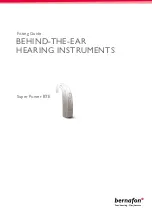Warning to hearing instrument dispensers
A hearing instrument dispenser should advise a prospective hearing instrument user
to consult immediately with a licensed physician (preferably an ear specialist) before
dispensing a hearing instrument. If the hearing instrument dispenser determines through
inquiry, actual observation, or review of any other available information concerning the
prospective user, that the prospective user has any of the following conditions:
(i)
Visible congenital or traumatic deformity of the ear.
(ii) History of active drainage from the ear within the previous 90 days.
(iii) History of sudden or rapidly progressive hearing loss within the previous 90 days.
(iv) Acute or chronic dizziness.
(v) Unilateral hearing loss of sudden or recent onset within the previous 90 days.
(vi) Audiometric air-bone gap equal to or greater than 15 decibels at 500 Hertz (Hz),
1,000 Hz, and 2,000 Hz.
(vii) Visible evidence of significant cerumen accumulation or a foreign body in the
ear canal.
(viii) Pain or discomfort in the ear.
Special care should be exercised in selecting and fitting a hearing instrument whose
maximum sound pressure capability exceeds 132 dB SPL as there may be risk of impairing
the remaining hearing of the hearing instrument user.
Important notice for prospective hearing instrument users
Good health practice requires that a person with a hearing loss have a medical evaluation
by a licensed physician (preferably a physician who specializes in diseases of the ear)
before purchasing a hearing instrument. Licensed physicians who specialize in diseases of
the ear are often referred to as Otolaryngologists, Otologists or Otorhinolaryngologists.
The purpose of medical evaluation is to ensure that all medically treatable conditions that
may affect hearing are identified and treated before the hearing instrument is purchased.
Following the medical evaluation, the physician will give you a written statement that
states that your hearing loss has been medically evaluated and that you may be considered
a candidate for a hearing instrument.
The physician will refer you to an audiologist or a hearing instrument dispenser, as
appropriate, for a hearing instrument evaluation.


















